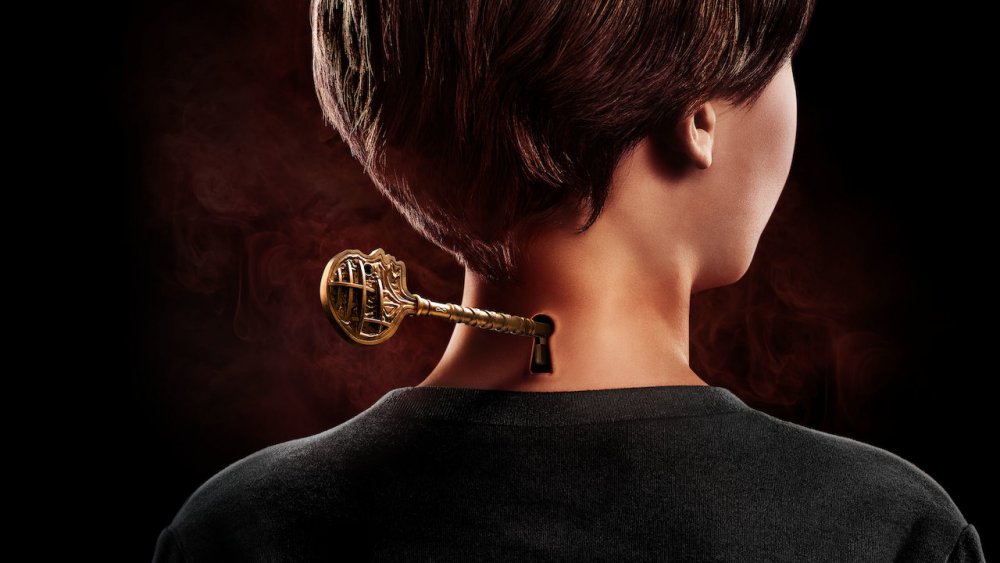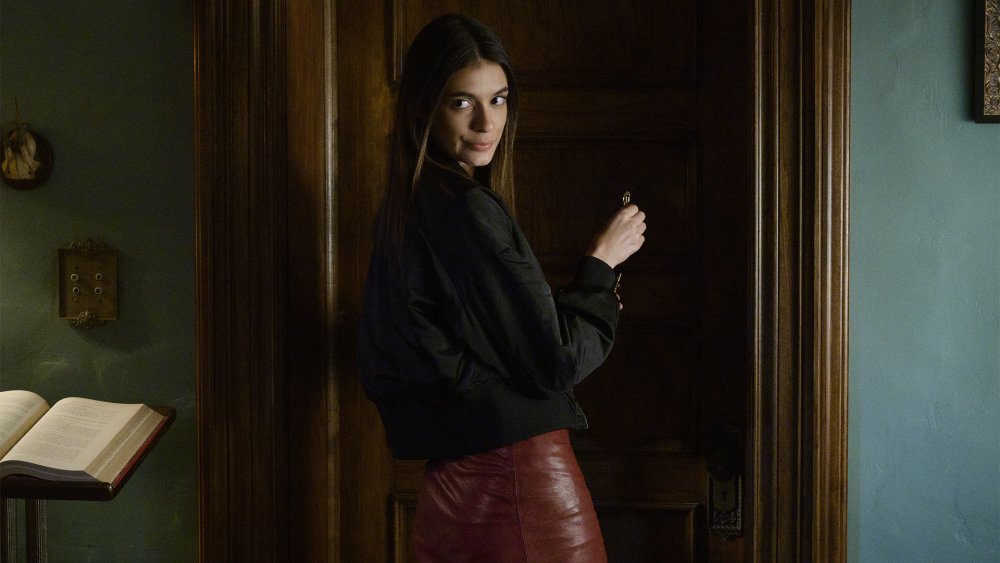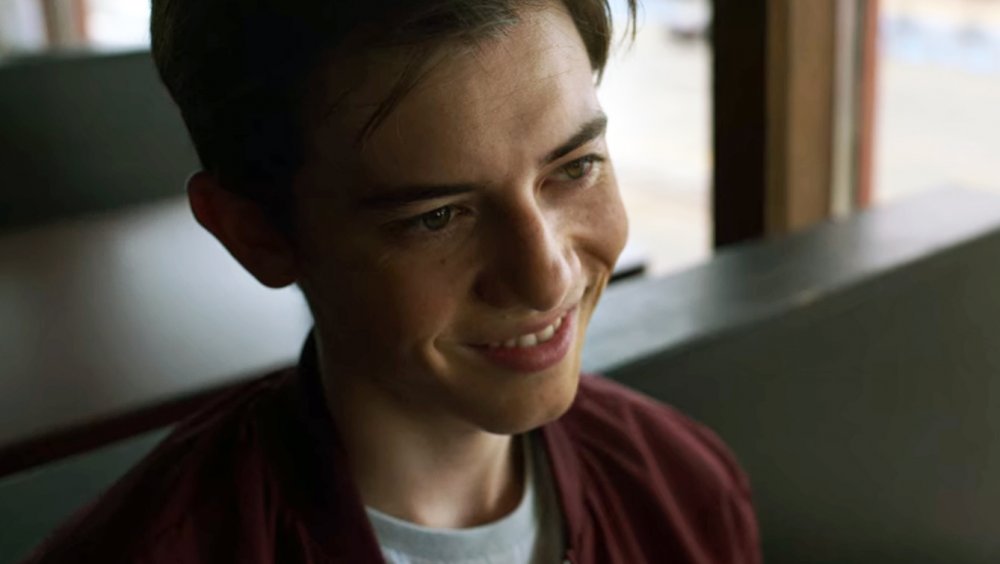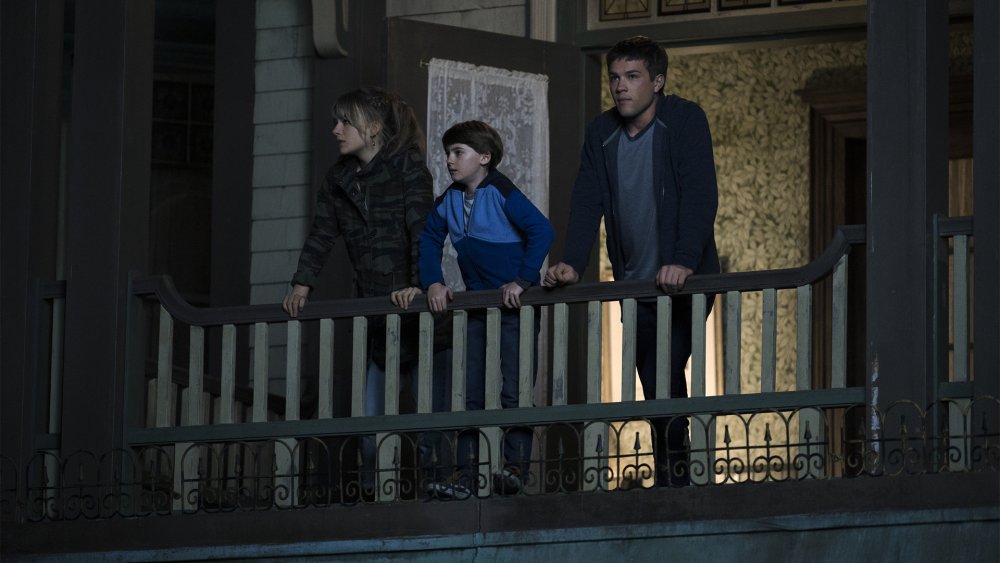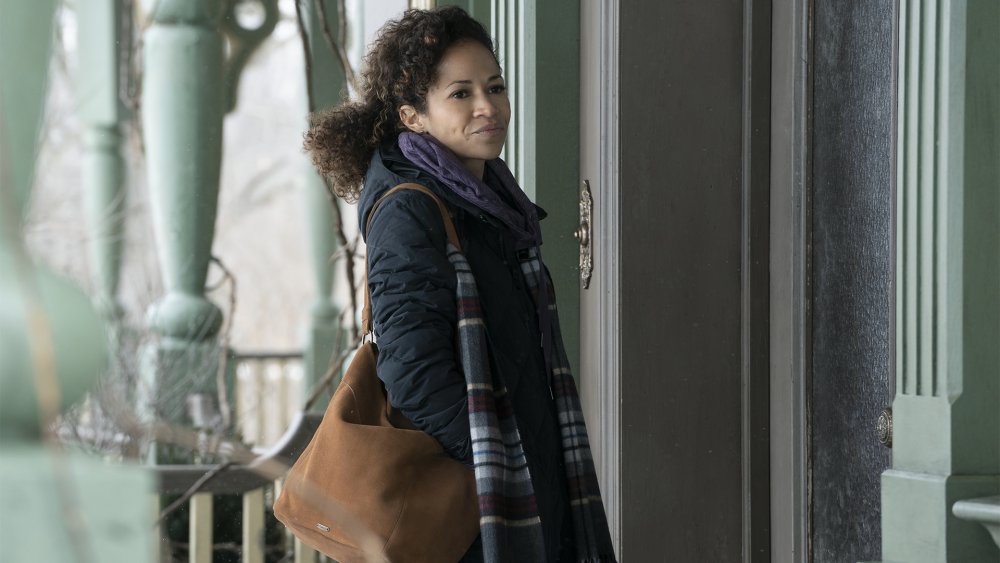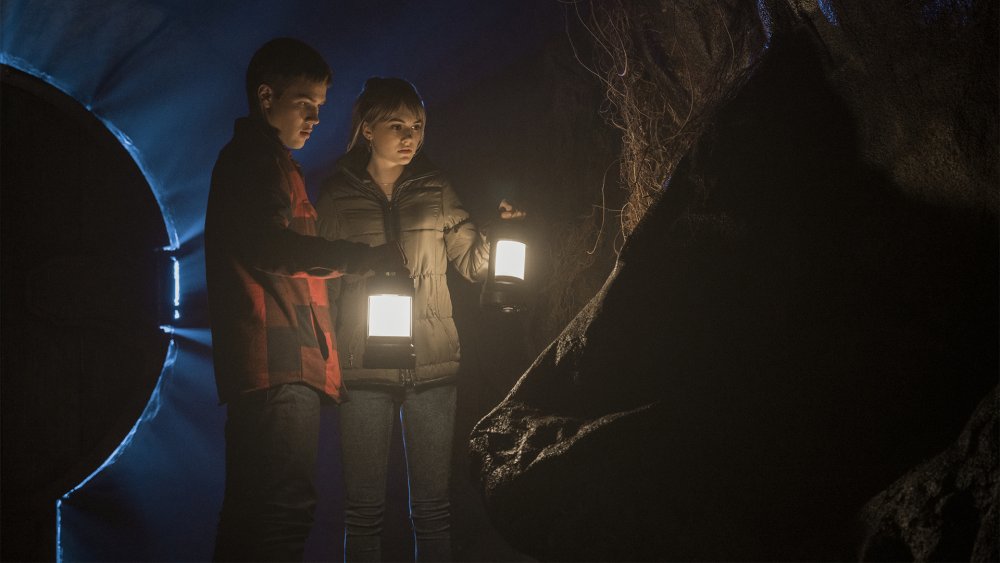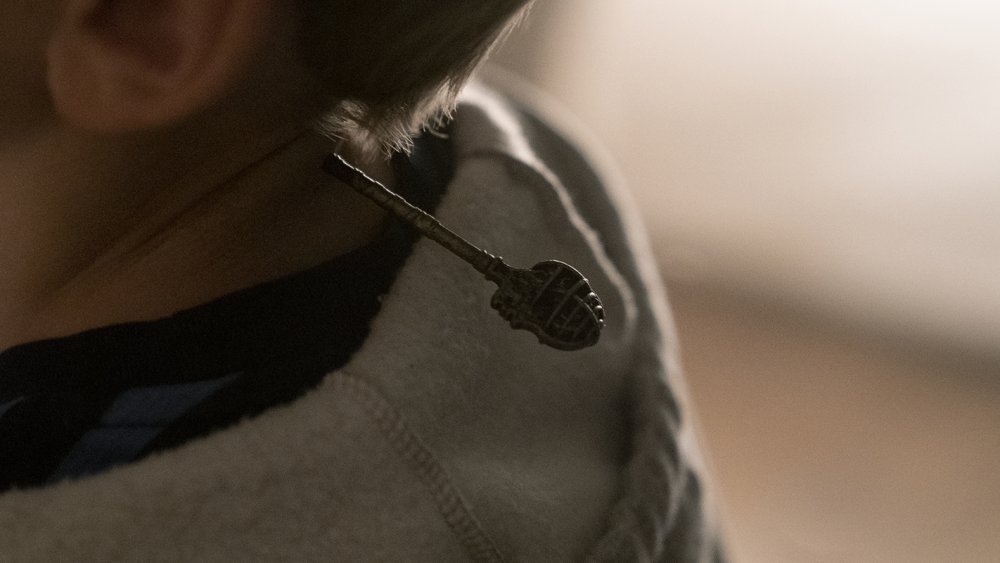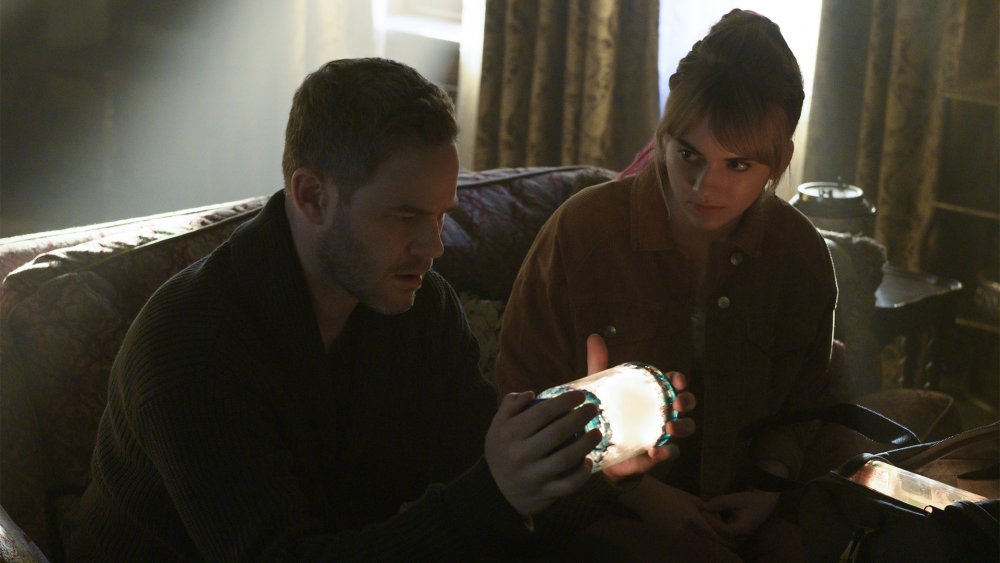The Ending Of Locke And Key Explained
Talk about a misdirect. In the final minutes of the first season of Netflix's Locke & Key, it sure looks like the Locke family has gotten their much-deserved happy ending.
Dodge, the evil, key-grabbing spirit from the Wellhouse, has been sent back to the dimension from whence she (or he?) came. Tyler, Kinsey, and Bode have put their father's death behind them and found a new life in the town of Matheson. Sure, there are still a few lingering loose ends, but for the most part, things are looking up.
Except that's not what happened at all. While the first season of Locke & Key blew through most of the plot in Joe Hill and Gabriel Rodriquez's original graphic novels, a few last-minute twists made it clear that the Netflix series is just getting started. If you're unclear as to how all the pieces fit together, want answers to some of Locke & Key's bigger questions, or just want some hints on where season two might head, here's what you need to know.
Dodge loves it when a plan comes together
At the end of the day, Dodge won. Dodge's real goal wasn't stealing the Omega Key. It was opening the Black Door. She didn't need the Omega Key to accomplish that. She simply had to trick Tyler, Kinsey, and Bode into opening the door for her.
Dodge's scheme isn't shown onscreen chronologically, so here's roughly how it works: First, Dodge knocks Ellie Whedon unconscious, and uses the Identity Key to transform the gym teacher into a clone of herself. Next, Dodges uses the Crown of Shadows to summon an army and leads an attack on Keyhouse. While the stakes feel real, they're not. Dodge intends to let the kids win. Then she drops Ellie's body, disguised as her own, and where the children can find it.
In order to dispose of Dodge for good, Tyler, Kinsey, and Bode need to put her back in the Wellhouse. Unfortunately, no one knows where Ellie hid the Echo Key, so instead, the kids decide to open the Black Door using the Omega Key and dump Dodge inside. See where this is going? The children and their friends throw Ellie's disguised body through the portal even as one of Dodge's demonic peers escape.
Dodge's biggest threat, Ellie, is gone, her other enemies think she's no longer part of the equation, and now she has an equally powerful partner in crime to help out. The Lockes think they won, but Dodge got everything she wanted.
Gabe's timeline, explained
Of course, getting rid of Ellie and opening the Black Door isn't the only way that Dodge has set herself up for success in season two. As the final moments of Locke & Key's first season reveal, she's also earned Kinsey's trust (and her heart) by using the Identity Key to masquerade as Gabe, a member of Kinsey's friend group.
As the season-closing montage implies, Dodge has been masquerading as Gabe since the very beginning. It was Dodge in the lobster suit. It was Dodge who tortured Eden using the Music Box Key. It was Dodge who stole Kinsey away from Scot. That tracks. Gabe doesn't appear until after Bode gives Dodge the Anywhere Key in the first episode, and his pitch-perfect emotional manipulation of Kinsey always felt a little predatory (presumably, there was a real Gabe at some point — it doesn't seem likely that the Savinis cast a complete stranger in their movie — although he might be dead).
The Dodge-Gabe deception echoes one of the graphic novel's main plotlines, although it works a little differently in the book. The Identity Key doesn't exist in the comics. Instead, Dodge uses something called the Gender Key to switch between her male and female forms. Masquerading as a boy named Zack, the male Dodge — who looks exactly like Ellie's old boyfriend, Lucas — becomes Tyler's best friend and Kinsey's boyfriend. Expect something similar to follow in season two.
A well-earned peace, if a temporary one
Still, it's not like Tyler, Kinsey, and Bode ended Locke & Key season one on a completely down note. While they might've been duped into a false sense of security, they did grow immensely thanks to their adventures in Keyhouse, and were finally able to get over the death of their dad, Rendell Locke.
When Locke & Key begins, Tyler blames himself for Rendell's murder. When Tyler's former classmate, Sam Lesser, makes a crack about offing his father, Tyler jokingly asks Sam to kill Rendell, too. When Sam actually does murder Rendell, Tyler can't help but feel responsible. Meanwhile, Kinsey can't forgive herself for being too afraid to fight Sam during the attack. Ultimately, Bode's trauma is a lot more simple: He just misses his dad.
However, after Sam visits Keyhouse and reveals that he's in league with Dodge, Tyler realizes that Rendell's death had nothing to do with him. Kinsey copes with her shame by literally removing her fear from her head, but only forgives herself once Tyler points out that she wasn't able to stop Sam because she was too busy protecting Bode. The youngest Locke sibling is now connected to Rendell's legacy through Keyhouse and the magic keys, which Rendell also used as a boy. The loss of Rendell will always be a big factor in the kids' lives, but as the season concludes, they're also, finally, able to move forward.
How did Ellie and Rendell remember the keys?
Magic is a finicky thing. While Keyhouse's keys are remarkably powerful objects, they come with one big caveat: only kids — specifically, only people under the age of 18 — seem to remember what they do. Every time Tyler, Kinsey, and Bode's mother Nina runs into one of the magical objects, she almost immediately forgets about the experience — except, oddly enough, when she's drunk.
However, both Ellie Whedon and Rendell Locke retained their memories of the keys into adulthood. For Rendell, that was the main reason he kept his family away from Keyhouse. For Ellie, that knowledge led her to use the Echo key to summon Dodge, which resulted in Rendell's murder and all the chaos that followed. They're not alone, either: Rendell and Ellie's old friend Mark also remembered Keyhouse's secrets, which is why he set himself on fire with the Matchstick Key at the beginning of the pilot.
Unfortunately, Locke & Key never explains how Rendell, Ellie, and Mark overcame the age barrier, although there's one hint: Rendell and Ellie have the exact same scar in the exact same spot on their body, which makes Nina instantly suspicious. Those scars might have something to do with why both Rendell and Ellie remembered the keys into adulthood. Just one problem: It doesn't look like Mark has a matching scar when he opens his shirt in the pilot, although he's kind of blurry in the shot so it's hard to tell for sure.
What is Dodge, and what's really behind the Black Door?
Netflix's Locke & Key is more of a remix of Joe Hill and Gabriel Rodriguez's comic book series than a straight-up adaptation. All of the major pieces are there, but they occur in a different order, and often for slightly different reasons. Still, so far the mythology of the series remains largely intact, meaning the comics are a good place to turn to answer some of the show's lingering questions.
For example, the Netflix series doesn't really delve into Dodge's origins, but the comic does. According to Hill and Rodriguez, Dodge is a member of a race of demons called the Children of Leng. The Black Door is a gateway to the Children's home dimension. As in the show, the Children of Leng can only live for a few moments in our world. If they don't possess a human being, binding themselves to the host's soul, they die.
The Children of Leng are actually a reference to the Plateau of Leng from H.P. Lovecraft's Cthulhu Mythos. In Lovecraft's works, the Plateau of Leng is the home to cannibal cultists, an abandoned city built by the godlike Old Ones, and the resting place for a race of goat-men, depending on the story. It's not the only Lovecraft reference in Locke & Key, either. The Children of Leng often shout the name of Shub-Niggurath, one of Lovecraft's evil goddesses, and in the comics the town where the Lockes live is actually known as Lovecraft, not Matheson.
Where did the keys come from, exactly?
The other big mystery that Locke & Key's first season leaves hanging is the keys' true nature. We know they're magic, but why are they in Keyhouse, and where did they come from? If Locke & Key continues to stick to the comic books' mythology, we can find the answer there, too: Quite simply, the keys are made out of the bodies of the Children of Leng, and were forged by the Lockes' ancestors in order to control the forces beyond the Black Door.
In the comics, when a Child of Leng comes out of the Black Door, they don't just die when they fail to find a host. They actually turn into a substance known as Whispering Iron. When Benjamin Locke discovered the Black Door during the Revolutionary War, he quickly realized how dangerous it was (well, okay, one of his fellow soldiers got possessed by the Children of Leng first) and used the Whispering Iron to make the Omega Key, keeping the door shut.
Benjamin went on to make a number of other keys, which he hid around Keyhouse for later generations to find. Again, later seasons of the Netflix show might retcon or streamline this history a little bit, but the show's been faithful so far. It doesn't seem likely to change too much.
The Locke & Key saga is only getting started
Even for comic book readers, it's hard to tell exactly where Netflix's Locke & Key is headed. The first season burned through lots of the comics' major plot points — Kinsey removing her fear using the Head Key, Joe Ridgeway's murder, Nina's struggles with alcoholism, the discovery of the Omega Key and the Black Door, Dodge's attack on Ellie, and more — leaving the future very murky.
Still, there are a few things we know. We haven't seen all of Keyhouse's magic keys. Without giving too much away, keys like the Animal Key, the Angel Key, the Owl Key, and the Giant Key will look great on screen and should be lots of fun. Duncan, the kids' friendly uncle, has very little to do in season one, but plays a much bigger role as the story progresses, and if you think Dodge is finished with Bode, just wait. The little guy is in for a very, very rough time.
The show also raises new questions that the comics never dealt with. Kinsey's fear is attacking her classmates. How will the kids stop it? Ellie isn't dead, she's just trapped beyond the Black Door. Is her time on the show done, or will she find a way back through? There are a lot of mysteries to resolve. Season two can't get here soon enough.
